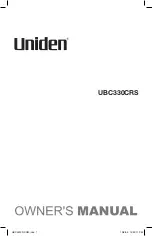
33
AVOIDING IMAGE FREQUENCIES
You might discover one of your regular stations on another frequency that is not list-
ed. It might be what is known as an image frequency. For example, you might find
a service that regularly uses a frequency of 431.975 also on 474.775.
To see if it is an image, do a little math.
Note the new frequency.
474.775
Double the intermediate frequency of 21.4 MHz (42.800)
and subtract it from the new frequency.
–42.800
If the answer is the regular frequency,
431.975
then you have tuned to an image.
Occasionally, you might get interference on a weak or distant channel from a strong
broadcast 42.8 MHz below the tuned frequency. This is rare, and the image signal
is usually cleared whenever there is a broadcast on the actual frequency.
FREQUENCY CONVERSION
The tuning location of a station can be expressed in frequency (kHz or MHz) or in
wavelength (meters). The following information can help you make the necessary
conversions.
1 MHz (million) = 1,000 kHz (thousand)
To convert MHz to kHz, multiply the number of megahertz by 1,000:
9.62 (MHz)
×
1000 = 9620 kHz
To convert from kHz to MHz, divide the number of kilohertz by 1,000:
2780 (kHz)
÷
1000
= 2.780 MHz
To convert MHz to meters, divide 300 by the number of megahertz:
300
÷
7.1 MHz = 42.25 meters
20-419.fm Page 33 Wednesday, March 24, 1999 2:43 PM








































